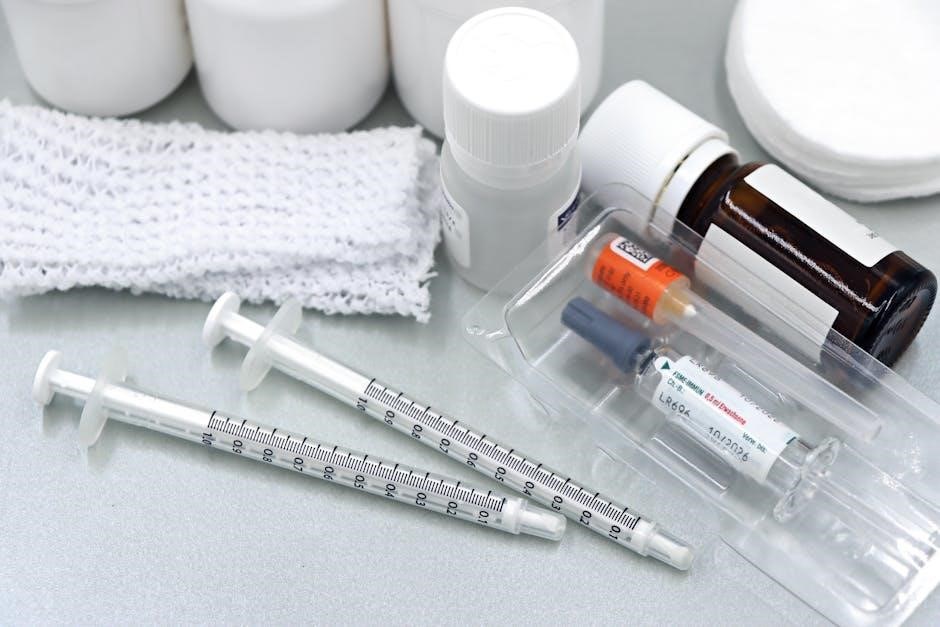A printable nurse brain sheet is a concise, organized tool used to capture essential patient information, helping nurses stay efficient and focused during shifts.
1.1 Definition and Purpose
A printable nurse brain sheet is a structured, pre-designed document used by nurses to organize and quickly access critical patient information. Its primary purpose is to serve as a readily available reference guide, ensuring that essential details such as medical history, medications, and vital signs are easily accessible during patient care. Designed to enhance efficiency, these sheets help nurses prioritize tasks, reduce errors, and maintain focus on providing high-quality care. They are particularly useful in fast-paced environments where quick decision-making is crucial. By standardizing the collection of patient data, brain sheets promote clarity and consistency, making them an indispensable tool for nurses across various healthcare settings.
1.2 Importance of Organization in Nursing Practice
Organization is a cornerstone of effective nursing practice, directly impacting patient safety and care quality. A well-structured approach ensures that nurses can manage multiple tasks efficiently, prioritize patient needs, and maintain accurate records. Disorganization can lead to missed medications, miscommunication, and errors, which may compromise patient outcomes. Printable nurse brain sheets play a vital role by providing a centralized, organized format for critical information, reducing the likelihood of oversight. By promoting order and clarity, these tools empower nurses to deliver consistent, high-quality care, even in the most demanding environments. Ultimately, organization enhances professionalism and accountability, safeguarding both patients and healthcare providers.

Key Components of a Nurse Brain Sheet
A nurse brain sheet typically includes patient demographics, medical history, current medications, vital signs, and monitoring parameters, serving as a quick reference for essential patient information.
2.1 Patient Demographics and Identification
Patient demographics and identification are crucial for personalizing care. This section includes the patient’s name, date of birth, medical record number, and contact details. It ensures accurate identification and tailored treatment plans.
2.2 Medical History and Allergies
Documentation of a patient’s medical history and allergies is vital for safe care delivery. This section includes past illnesses, surgeries, and chronic conditions, as well as known drug, food, or environmental allergies. Accurate recording helps prevent adverse reactions and informs treatment decisions. Nurses must ensure this information is up-to-date and clearly highlighted to avoid potential errors. Including allergy specifics, such as the type of reaction, enhances safety. Regular updates to this section are essential, especially for patients with evolving conditions or new sensitivities. This ensures continuity of care and minimizes risks, making it a cornerstone of effective patient management and nursing practice.
2.3 Current Medications and Dosages
Accurate documentation of current medications and dosages is critical for patient safety and effective care. This section includes the medication name, dosage, frequency, and route of administration. It ensures continuity of care and prevents errors. Nurses must verify medication lists regularly, especially during transitions of care. Highlighting any changes or potential interactions is essential. This section also includes PRN medications and any recent adjustments. Clear documentation helps prevent omissions or overdoses, ensuring patients receive the correct treatments. Regular updates are necessary to reflect new prescriptions or discontinuations, making this a vital part of the brain sheet for delivering safe, personalized care.
2.4 Vital Signs and Monitoring Parameters
Vital signs and monitoring parameters are essential components of a nurse brain sheet, providing critical data for patient assessment. This section typically includes temperature, heart rate, blood pressure, respiratory rate, and oxygen saturation. Monitoring parameters may also cover pain levels, neurological status, and fluid intake/output. Accurate documentation of these metrics helps identify trends and deviations from baseline, enabling timely interventions. Regular updates ensure continuity of care, especially for critically ill patients. Including abnormal ranges or alerts can enhance situational awareness. This section is vital for tracking patient stability and guiding clinical decisions, making it a cornerstone of effective nursing documentation.

Legal and Professional Considerations
Legal and professional considerations ensure nurses adhere to regulations, maintain patient confidentiality, and uphold ethical standards, crucial for trustworthy care in healthcare settings.
3.1 Confidentiality and HIPAA Compliance
Printable nurse brain sheets must adhere to strict confidentiality and HIPAA compliance standards to protect patient information. Nurses are legally obligated to safeguard patient data, ensuring it is only accessed by authorized personnel. HIPAA regulations require that all patient information, whether in digital or printable formats, is handled securely to prevent unauthorized disclosure. Printable brain sheets should be stored in secure locations, and access should be limited to maintain confidentiality. Proper disposal methods, such as shredding, should be used to protect sensitive data. Violations of HIPAA can result in severe legal consequences, emphasizing the importance of adhering to these guidelines in nursing practice.
3.2 Documentation Standards in Nursing
Printable nurse brain sheets must align with established documentation standards in nursing to ensure accuracy, clarity, and completeness of patient records. Proper documentation is critical for legal accountability, continuity of care, and patient safety. Nurses are expected to record patient information in a timely, legible, and organized manner, adhering to professional guidelines. This includes using standardized terminology and avoiding abbreviations that could lead to misunderstandings. Documentation should reflect the patient’s condition, interventions, and outcomes, serving as a clear communication tool among healthcare providers. Adhering to these standards ensures that printable brain sheets remain reliable and effective tools in nursing practice.

3.3 Citation of Sources and Avoiding Plagiarism
When creating printable nurse brain sheets, it is crucial to cite sources properly to avoid plagiarism and maintain professional integrity. Nurses must ensure that any information borrowed from external resources, such as medical guidelines or research, is clearly attributed to its original author or publication. This includes noting the author’s name, the title of the work, and where it can be accessed. Failing to cite sources can lead to legal and ethical issues, undermining the credibility of the brain sheet. Proper citation also ensures that the information is traceable, allowing for verification of accuracy. By adhering to these standards, nurses can create reliable and ethical tools for patient care.

Tips for Creating an Effective Brain Sheet
Focus on key patient data, use clear language, and customize templates to meet specific needs, ensuring accuracy and efficiency in daily nursing practice and patient care delivery.
4.1 Prioritizing Essential Information
Prioritizing essential information is critical for creating an effective brain sheet. Focus on patient demographics, medical history, current medications, allergies, and vital signs to ensure clarity and relevance. Avoid clutter by excluding non-essential details. Organize data logically, starting with the most critical information at the top. Use clear headings and categories to enhance readability. This approach helps nurses quickly access vital patient details during emergencies or routine care. Regularly reviewing and updating the brain sheet ensures accuracy and reflects the patient’s current condition. By emphasizing key information, nurses can improve decision-making and patient outcomes, making the brain sheet an indispensable tool in daily practice.
4.2 Using Clear and Concise Language
Using clear and concise language is vital for effective communication in nursing practice; Brain sheets should avoid ambiguity to ensure quick comprehension during emergencies. Nurses should use simple, straightforward terminology and avoid jargon or overly complex phrases. Bullet points and short sentences can enhance readability, making it easier to scan information rapidly. Standardizing terms and abbreviations across the brain sheet minimizes confusion. For example, listing medications with dosages and frequencies in a structured format improves clarity. Clear language also reduces errors in interpretation, ensuring accurate care delivery. By prioritizing simplicity, nurses can communicate effectively, improving patient outcomes and streamlining workflow. Clarity is key to reliability and efficiency in brain sheet usage.
4.3 Customization for Specific Patient Needs
Customizing printable nurse brain sheets to meet specific patient needs ensures personalized and effective care. Nurses can tailor templates to include or emphasize information relevant to individual patients, such as chronic conditions, allergies, or specialized treatment plans. For example, a brain sheet for a pediatric patient might prioritize vaccination schedules and growth charts, while one for a geriatric patient could focus on medication management and fall risk assessments. Adding or removing sections based on patient-specific requirements enhances clarity and reduces clutter. This adaptability allows nurses to stay organized while addressing unique care demands, ultimately improving patient outcomes and streamlining workflows. Customization ensures that brain sheets remain practical and patient-centered tools in diverse healthcare settings.
Digital vs. Printable Brain Sheets
Printable brain sheets offer portability and ease of use, while digital tools provide real-time updates and accessibility, catering to different nursing preferences and healthcare settings effectively.

5.1 Advantages of Printable Formats
Printable nurse brain sheets offer numerous advantages, including portability and accessibility without the need for digital devices. They are easy to use, allowing nurses to quickly jot down essential patient information with pen and paper. The tactile nature of printable sheets can enhance organization and memory retention. Additionally, they eliminate distractions from notifications or screen time, helping nurses focus solely on patient care. Printable formats are also reliable in settings with limited technology or power outages. They are environmentally friendly when printed on recycled paper and can be easily shared among healthcare teams. Furthermore, printable sheets are cost-effective and customizable to meet specific nursing needs, making them a practical choice for many healthcare professionals.
5.2 Benefits of Digital Tools for Nursing
Digital tools for nursing offer enhanced efficiency and accessibility, allowing nurses to quickly access and update patient information from any device. They enable real-time collaboration, reducing errors and improving communication among healthcare teams. Digital brain sheets can be easily customized and shared, ensuring consistency in patient care. Cloud-based solutions provide secure storage and retrieval of sensitive data, complying with HIPAA standards. Automated features, such as medication calculators and vital sign trackers, streamline workflows and reduce paperwork. Digital tools also support integration with electronic health records (EHRs), enhancing data accuracy and continuity of care. Additionally, they offer instant access to medical references, guidelines, and updates, aiding in informed decision-making. Overall, digital tools empower nurses to deliver high-quality, patient-centered care efficiently and effectively.
Printable nurse brain sheets are essential tools for organizing patient information, enhancing care coordination, and ensuring accuracy. They remain vital in modern nursing practice, adapting to future healthcare needs.
6.1 Summary of Best Practices
To create an effective printable nurse brain sheet, prioritize essential patient information, use clear and concise language, and ensure readability. Customize the format to meet specific patient needs while maintaining HIPAA compliance and documentation standards. Regularly update the content to reflect current medical practices and patient statuses. Validate assessments to ensure accuracy and reliability in nursing care. Avoid plagiarism by properly citing sources when incorporating external information; Finally, consider the benefits of both printable and digital formats, selecting the option that best aligns with your workflow and patient care goals. These practices enhance organization, efficiency, and the quality of care provided.
6.2 The Future of Nurse Brain Sheets in Healthcare
The future of nurse brain sheets lies in integrating digital and printable formats to enhance accessibility and efficiency. As healthcare evolves, digital tools will likely dominate, offering real-time updates and improved collaboration. Printable versions will remain valuable in settings with limited technology. Advances in AI and automation may enable brain sheets to predict patient needs and streamline documentation. Ensuring HIPAA compliance and interoperability with electronic health records (EHRs) will be critical. The evolution of brain sheets will focus on balancing tradition with innovation, providing nurses with versatile, reliable tools to deliver high-quality patient care in diverse healthcare environments.
